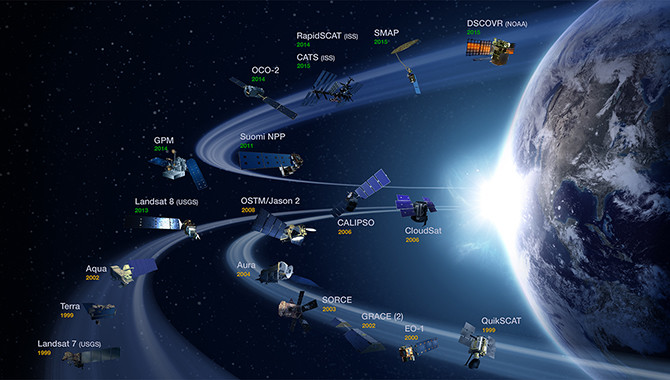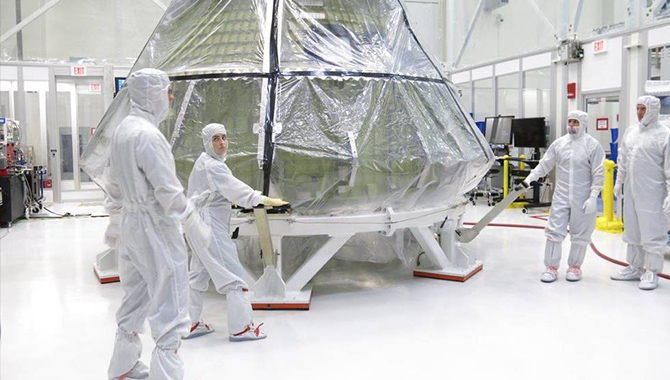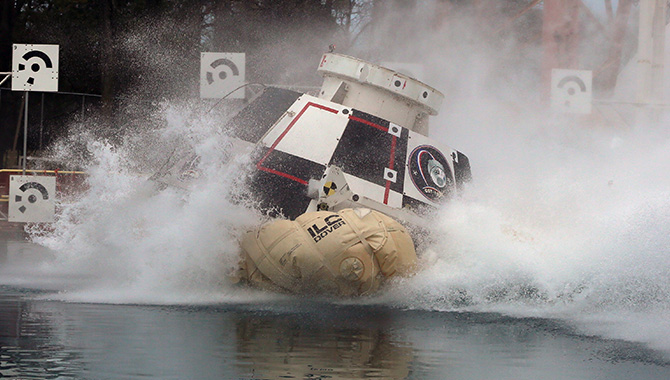
An artist’s illustration of ongoing NASA Earth Science Division missions as of June 2015.
Image Credit: NASA
A new report from the National Academies of Sciences, Engineering, and Medicine offers a novel framework for prioritizing resources to deliver on key Earth science objectives.
NASA’s Earth Science Division (ESD), part of the Science Mission Directorate (SMD), leads the way in using space-based observations to advance scientific understanding of Earth. Earth is a dynamic system made up of difference components that interact in complex ways. Developing a better understanding of how these elements affect each other, how they affect life on Earth, and how human activities impact the systems, is critical. Through projects such as the Orbiting Carbon Observatory 2 (OCO-2), ESD addresses this need by conducting long-term measurements of different aspects of Earth-system activities in order to enhance the ability to predict changes in weather, climate, and sea level, respond to natural disasters, and manage natural resources.
ESD research focuses on a variety of areas, including the atmosphere, oceans, land surfaces, and the biosphere. Research is conducted primarily through a series of coordinated satellite and airborne missions that undertake long-term observations of these Earth systems. Like all federal agencies, NASA conducts its efforts within a cost-constrained environment. Furthermore, in addition to managing its native work, in recent years ESD has been asked to maintain measurements previously undertaken by other agencies.
To effectively manage its resources, ESD approached the National Research Council (NRC) to convene a committee to develop a methodology for determining the relative value of the long-term measurements obtained through ESD’s various initiatives in order to prioritize them for investment. The division was particularly interested in determining which observations, when measured over long periods of time, provide the greatest value to the scientific community and benefit to society overall.
The NRC committee released its findings in a recent report: Continuity of NASA Earth Observations from Space: A Value Framework. To develop the value framework, the committee established quantified objectives: clear scientific goals based on recommendations in NRC decadal surveys and input from the White House and Congress. They then established a methodology that enables ESD to rate the relative value of different long-term measurements according to their relevance to the established quantified objectives.
The proposed framework utilizes five characteristics to assess the value of each measurement:
- The scientific importance of the quantified objective associated with the measurement
- The utility of the measurement
- The quality of the measurement in achieving the desired information
- The likelihood of success in capturing the measurement
- The affordability of continuing the measurement
The ESD can use the resulting ratings to determine each measurement’s overall value to the division as well as to other scientific or governing communities. While aspects of the evaluation process remain subjective, the overall framework conveys a degree of scientific rigor, relevance to long-term objectives, and transparency that enhances the decision-making process. The framework may have even greater value when paired with future NRC decadal surveys, which could be tasked to identify and prioritize all quantified objectives associated with the survey’s recommended science goals.
The framework represents an important first step in establishing a value-based decision-making process to optimize the allocation of resources within ESD. With such a system in place—and by refining the framework over time—ESD can determine which projects, and approaches within projects, best serve the division, the agency, and the nation overall.
Read the full report: Continuity of NASA Earth Observations from Space: A Value Framework.









